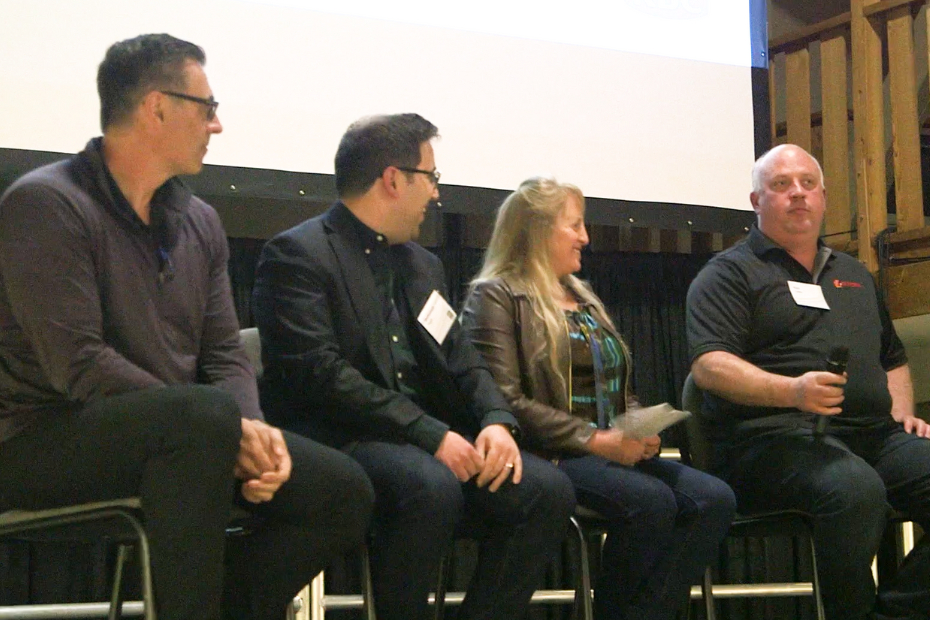The Next Green Revolution in Lethbridge, Alta.: How policymakers and farmers can come together to create effective agriculture policies

Published August 16, 2023 • 6 Min Read
-
Ken Coles, Executive Director, Farming Smarter
-
Janice Tranberg, President & CEO, Alberta Cattle Feeders Association and National Cattle Feeders Association
-
Mohamad Yaghi, Agriculture & Climate Policy Lead, RBC
-
Shaun Haney, Owner, RealAgriculture
Here are some of the major takeaways from the discussion.
Farmers need to be involved in policymaking
One of the many shared sentiments of the evening’s discussion was that farmers need to be more engaged in conversations around farming and the policies governments craft related to the topic.
At issue, Shaun suggested, is that officials and farmers don’t often speak the same language about sustainable agriculture.
“I think a lot of times we spend… our time arguing over the verbiage,” he said. “It’s a hardship for us to try to figure out how to be able to have a conversation at the same level as some of the [government officials] that we are talking to.”
He noted for many farmers, mentioning the words “sustainability” and “agriculture” in the same sentence can be confusing because they believe what they’re doing is sustainable. But Shaun noted sustainability involves more than just working one’s own plot of land.
“What needs to be worked into the conversation [around sustainability] is the fact that it not only covers the environment, but also covers things like financial sustainability, community sustainability, and many, many different things.”
To bridge the gap, Janice suggested government officials should spend more time connecting with farmers and trying to understand what they need and what their pain points are. For example, she noted, many discussions about agriculture policy happen during busy farming periods – like seeding or harvest – which makes it difficult for farmers to take part. This could be avoided if consultations were scheduled based on growing seasons and policymakers actively sought out input from farmers to learn about what’s happening on the ground.
This is all critical, Ken pointed out, because a big downside of not having farmers at the table of policy discussions is that whatever is crafted may not include feedback from those who understand what’s happening on the land best.
Farming is inherently regional
Tied to this conversation around making policy decisions in a collaborative fashion was the topic of regionality.
The same policies created to support agriculture in Europe or the United States should not be applied to Canada because the soil conditions, climate, and economic support systems between countries (and even cities) are different.
Looking at everything with a local lens is critical, Shaun added.
He compared the Canadian farming industry to the airline industry, noting the two are vastly different. With the airline industry, government officials can talk to three companies – Porter, WestJet, and Air Canada – and create policies that cover different geographies holistically because the companies have the same problems and can speak with one voice.
“Our industry… you look at the Palliser Triangle versus northern Alberta to Saskatchewan and to PEI… there are issues that are similar, but there are some really different ones… and that’s the difficult part about this,” he said. “It’s hard to get policymakers’ heads around the fact that cover crops may work in Southern Ontario for a certain purpose – and that’s good – but in the Palliser Triangle where we are, we’re just happy if it rains a little bit.”
The solution, the panelists agreed, is to create policies and goals that are tailored to each region.
Funding innovation is critical
To make the Canadian farming industry more environmentally sustainable, it’s also critical that farmers be given the tools (and/or funding) they need to make their workflows and processes more energy efficient.
Janice said a key gap on the government side is the speed at which innovative products get approved from a regulatory perspective. She pointed to 3-NOP (a methane inhibitor) as an example. It’s been proven the additive works to reduce methane emissions in beef and dairy cattle, but the government has been slow to approve its use.
“With the arduous regulatory process and the smaller market [here in Canada], what’s the incentive for a company like that [to come here]?” she said, noting it puts farmers in a position where they can’t advance at the same clip as those in other countries.
What’s needed is for famers to get their hands on innovative tools that feed them more data about how their production processes are functioning sooner. This can help them adopt workflows to make things more energy efficient.
“Farmers like gear… we can really get our head wrapped around technology,” Shaun said. “We like things that provide not only a benefit to the output we’re trying to accomplish, but also obviously to have a return on investment.”
Ken went on to add that farming is really a business of risk management – and innovation is a risky venture – so most farmers are open to the idea of trying new things to make everything they do function better and more energy efficient. What’s required is for the government to fund trials with new technologies.
“If you’ve got growers that are out there trying new things, then they need a break, they need a little help, a little nudge to be able to try something new and to take on a new piece of equipment, whatever that may be.”
This is where, Shaun noted, banks like RBC can – and should – help.
“One of the ways to solve some of the problems that we are trying to fix is through technology and innovation, so as one of the major lenders in the country, I think [RBC] funding technology [is critical],” he said. “And doing [funding] appropriately, so there aren’t unintended financial consequences created by weaving environmental policy into lending agreements.”
Mohamed agreed, noting The Next Green Revolution speaker series is meant to be a starting point to kick-start critical conversations.
To learn more about RBC’s recent report The Next Green Revolution, click here.
You can also hear what agriculture industry experts and farmers at our other events had to say about the future of farming when it comes to sustainable agriculture.
While information presented is believed to be factual and current, its accuracy is not guaranteed and it should not be regarded as a complete analysis of the subject matter discussed. All expressions of opinion reflect the judgment of the author(s) as of the date of publication and are subject to change. No endorsement of any third parties or their advice, opinions, information, products or services is expressly given or implied by Royal Bank of Canada or its affiliates.
This article is intended as general information only and is not to be relied upon as constituting legal, financial or other professional advice. A professional advisor should be consulted regarding your specific situation. Information presented is believed to be factual and up-to-date but we do not guarantee its accuracy and it should not be regarded as a complete analysis of the subjects discussed. All expressions of opinion reflect the judgment of the authors as of the date of publication and are subject to change. No endorsement of any third parties or their advice, opinions, information, products or services is expressly given or implied by Royal Bank of Canada or any of its affiliates.
Share This Article





